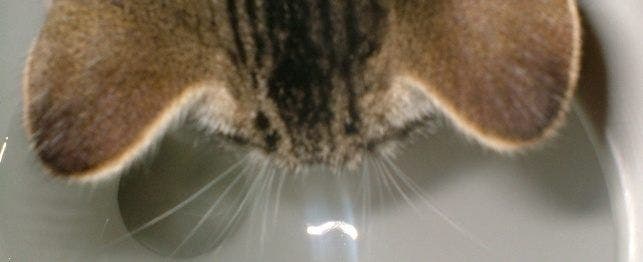
How to Toilet Train Your Cat
Every cat lover who saw the movie Meet the Parents envies Robert DeNiro’s character, whose seal point Himalayan cat, Mr. Jinx, used the toilet to eliminate his wastes. Think of the convenience: no more hoisting bags of litter into and out of the car, no more scooping waste from the litter box and throwing it into the trash, and no more smell when Rocko makes a hefty deposit in (or outside of) his box. With the exception of flushing, a toilet-trained cat eliminates all of the problems associated with managing pet poop.
Many cats instinctively bury their waste to hide the scent from potential predators. When you toilet train your cat, you condition him to abandon those instincts in favor of simply dropping his waste into a water-filled container. On the other hand, cats are clean-freaks, so the absence of odors associated with a litter box may well fit in with their natural predilection. “Toilet training makes a cat more secure because the smell goes away,” says Eric Brotman, Ph.D., author of How To Toilet Train Your Cat: The Education of Mango (Bird Brain Press). “It fits in with their hard-wiring.”
If you have a cat that is over the age of 6 months and knows how to use a litter box, you can toilet train him. Younger cats are more easily trained, but age is no obstacle. “If the cat doesn’t have problems using a litter box, there is no reason he can’t learn a new behavior,” says Brotman.
The equipment one needs to toilet train a cat is minimal. “A tin roasting pan and duct tape,” says Brotman, “and the cat, of course.” Although there are kitty toilet-training kits on the market, a kit is not necessary to succeed, and, if your cat is larger than the litter box supplied in the kit, it may actually impede progress.
Cats can be trained in as little as 3 weeks, but it may take longer. “It’s variable,” says Brotman. “It depends on the cat’s inclination and the owner’s commitment and understanding. It can take 3 to 4 months, but the average is about 3 to 4 weeks.”
To toilet train your cat, follow the simple steps below. If at any time your cat appears reluctant to move on, go back a step or two, and start again. Don’t force your cat to do something he is uncomfortable with.
ADDITIONAL LINKS
For more information on traditional litter box training, please read Litter Box Training Your Cat.
If your cat is not using the litter box, please read Inappropriate Elimination in Cats.
The Steps
Place your cat’s usual litter box next to the toilet. Allow him several days or even a week to become accustomed to the new location.
Over the course of a week or two, elevate the litter box a few inches at a time until it is the height of the toilet seat. You can use telephone books, stacks of magazines or newspapers, anything that will add height (but not fall over) as your cat is using the box. If the stack falls, it can make your cat hesitant about using the box altogether, let alone one that is off the floor. Allow your cat time enough to get used to the elevated height.
Once the box is the correct height, place it directly on the toilet, with the lid up but the seat down. Remove whatever materials you used to elevate the box. Let your cat get used to the location.
“Once your cat has learned to do his business at the height of the toilet, place an aluminum roasting pan over the toilet but under the seat,” says Brotman. Tape it in place with the duct tape to prevent it from sliding around. From now on, you must leave the seat down and the toilet lid up. A word of caution though: avoid using an automatic toilet bowl cleaners. Chances are your cat won’t drink from the same toilet in which he eliminates, but if he does, he could become ill from any chemicals in the water.
Your cat will be used to digging in the litter to deposit wastes, so place a small amount of litter in the aluminum baking pan. Poke a small hole in the center of the roasting pan to allow liquid to drain away. “Gradually enlarge the hole in the pan,” says Brotman. “The litter will eventually start to fall through.” (By the way, it’s best to use flushable litter at this stage of the proceedings).
As the hole becomes larger, your cat will be unable to stand in the pan. When that occurs, he will balance himself on the seat. When you notice your cat is comfortable with standing on the toilet seat, take the roasting pan away. At this point, your cat should be able to eliminate into the toilet without the training aids.
The time it takes to learn to use the toilet is different for each cat. If your cat is reluctant at any stage of training, go back a step or two. “Don’t freak out,” says Brotman. “Slow down and go back a little bit. You have to be patient.”
If you would like to read more details about toilet training your cat and see photographs of a cat who was successfully trained, check out How To Toilet Train Your Cat: The Education of Mango by Eric Brotman, Ph.D. (ISBN 0-9707327-0-8) from Bird Brain Press, Inc. The book can be purchased by calling 909.498.7570 or by ordering it online at Birdbrainpress.com.